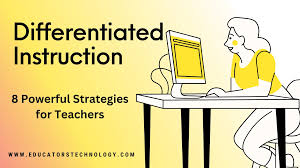In the world of education, differentiation is crucial for promoting student success. Differentiation refers to the process of tailoring instruction and educational experiences to match each individual student’s unique learning style, strengths, and needs. By implementing differentiation strategies, teachers can create a more inclusive and equitable learning environment that encourages growth, engagement, and achievement for all students. Here are eight ways to get real with student differentiation:
1. Know your students
To truly differentiate instruction, you need to know your students – their interests, learning styles, strengths, and challenges. Invest time in building relationships with students by having honest conversations, conducting surveys or questionnaires, reviewing previous school records, and observing their interactions in the classroom.
2. Mix it up with multiple intelligences
Different students respond to different types of instruction based on their unique blend of multiple intelligences. Incorporate a variety of teaching methods in your lessons that cater to different abilities and preferences – from visual aids and auditory tools to kinesthetic activities and group work.
3. Use flexible grouping strategies
Grouping students by ability level allows you to tailor instruction that challenges each student at their optimal level of growth. Utilize flexible grouping strategies like small-group instruction, partner work, or rotating stations so that students have opportunities to collaborate with peers who have diverse abilities.
4. Create tiered assignments
Tiered assignments present a common learning goal but offer varying levels of complexity and support based on each student’s needs. Design activities that allow students to demonstrate their understanding in different ways while still meeting the main objective.
5. Scaffold with instructional supports
Scaffolding provides temporary supports for students as they learn new skills or concepts. Incorporate resources like graphic organizers, guided questioning techniques, visual cues, or modified text to help learners bridge gaps in understanding.
6. Embrace the power of choice
Empower your students by offering choices in how they engage with the curriculum. Allow students to choose from a variety of assignments, projects, or activities that cater to their individual interests and learning preferences.
7. Assess and adjust
Ongoing assessment is fundamental for effective differentiation. Use formative assessments like exit tickets, quizzes, or class discussions to regularly gauge student understanding and adjust your instruction accordingly.
8. Foster a growth mindset
Encourage a culture of growth and resilience in your classroom by praising effort rather than innate ability. Teach students that challenges are opportunities to grow, and provide specific feedback on ways they can improve their skills.
By implementing these strategies in your classroom, you can develop a more inclusive environment that caters to the diverse needs of your students. Remember, differentiation is an ongoing process – embrace flexibility, and continuously adapt to ensure that every student has the opportunity to succeed.





